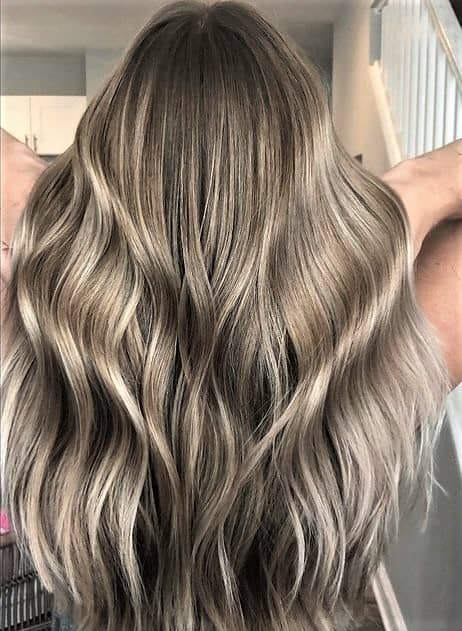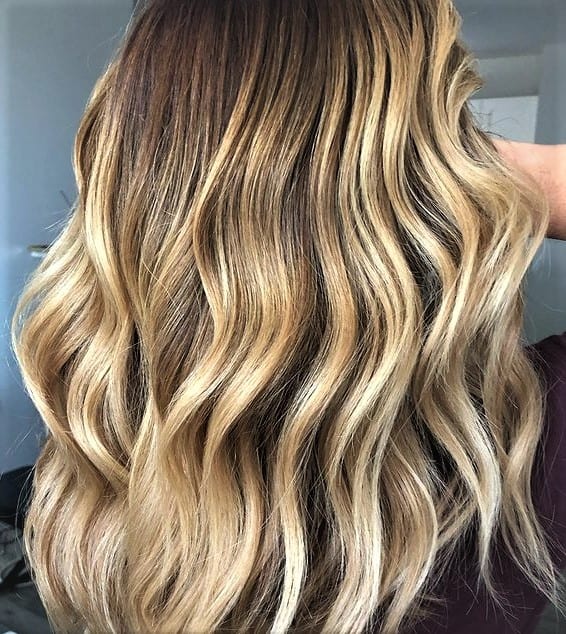Last Updated on September 27, 2023 by Andrea Haynes
Written by Andrea HaynesSummer is just around the corner, and no doubt that urge to highlight your hair peaks every time the sun comes out. But before you dive right into the salon and say “make me blonde” you may want to know what you’re getting yourself into and why.
There are so many different types of highlights that this topic is not always easy to understand. Usually reading the language will be enough to throw you off, but then when you google images of balayage, foiliage, ombre, full foiled highlights, etc. things only get more confusing.
I want to help take out the blurry definitions and give you a solid understanding of the varied types of highlights so you can look sun-kissed or platinum in time for summer. And there’s no better time in 2022 than right now to get this process going.
Amazing Types of Hair Highlights to Choose from in 2022
1. Full or Partial Balayage

If you’re hoping to get something very natural-looking that might only be a couple of shades lighter than your natural color, then balayage is a good option. Each piece is hand-painted with precision and just the right amount of saturation to give you the sun-kissed look of your dreams. So what exactly do you need to know about balayage? Just a few easy takeaways.
Balayage is a naturally “warm-color” producing process. If you like golds, warm browns, reds, honey, and champagne then this will fit your aesthetic.
What’s the Difference Between a Full and a Partial Balayage?
- A full balayage covers all areas of the head, including the back underneath the crown down to the nape of the neck.
- A partial only covers the upper portion of the head from the back crown to the upper portion of each side of the head.
Why should you choose a partial or a full balayage? Partial Balayage creates more “dimension.” It’s a higher contrast effect where there are naturally deeper lowlights created from your natural hair color. The takeaway is if you want high contrast with balayage, try a few partials in a row spaced 8-10 weeks apart.
Toners are often needed to soften the level of red, copper, orange, or gold that might be produced from the bleaching process. These warm color pigments live naturally in the hair and become exposed once the bleach does its job. So don’t be worried in the process. Your colorist knows what they are doing.
Toners are often needed every 6-8 weeks between services to keep the tone in the right color spectrum.
How often should you get a balayage per year? This will vary but on average people do 2-5 per year.
2. Foiliage

When you hear the word foiliage, think bright blonde with an easy grow out. With this process, you get the best of two worlds: the brightness of “foiled highlights” mixed with the easy outgrowth of a balayage. @lo_Wheelerdavis is a luxury hair artist from California who specializes in creating high-contrast, rooty blondes. For inspiration, she is a good place to start. You’ll find everything about this look on her page, plus more.
So what do you need to know about foiliage?
- Using foils creates deeper saturation and heat when the product comes in contact with the hair. It’s a physically more intense process for your cuticles so take care of them in a few ways: get keratins, use hair masks 1-3x per week, try the Olaplex line, and stay regular with your upkeep.
- Foiliage is meant to be for high contrast. If you’re torn between foils and balayage, try foiliage.
- It is still a rooted look, so you are growing out your highlights easier, although still not as easy as a balayage.
- Often needs to be color melted post highlighting service.
3. Color Melt (NOT A HIGHLIGHT TECHNIQUE)
Often your foiliage, balayage, or foiled highlights will be followed by a color melt. Your colorist takes 2-3 colors and starts with the darkest toner at the root, then moving a couple of inches down at a time uses a slightly lighter toner for the mid-sections of the hair until the end is reached where the lightest toner is applied.

What do you need to know about a color melt?
- This is a toning process, not a bleaching or highlighting service.
- Color melting takes a lot of skills and expertise to do well. The use of three colors is slightly misleading as the color for each section as you move down in a gradient from dark to light will have multiple colors mixed in to achieve it. So for example, you’re using a dark color at the base of your hair and it could be mixed with 3 different colors to make it that shade. The same goes for the midsection color and the ends. It’s complex!
- It’s a conditioning process with certain brands. Some glosses act like an end-of-service shield, sealing down those cuticles and making the hair shiny and healthy-feeling.
- You may not need a color melt as often as you would a single toner.
4. Babylights
A good technique for the blonde that feels never quite blonde enough but still stays shy of platinum. The results of babylights are gorgeous and can be considered high maintenance.

So what are the key concepts for babylights?
- Long service. This process takes paper-thin sections and applies the bleach or lightening agent to them inside folded foils. Due to the tiny section size, the process can take a very long time. Bring a book and a snack!
- It’s high-maintenance blonding for a reason. You’re achieving the brightest blonde possible here just shy of a double-process platinum experience. This means to maintain that blonde, you’ll need to be booking regular touch-up services every 8-10 weeks.
- Aftercare is important. You’ve invested a lot of time and money into this process so taking care of it provides the best benefits. Remember to get keratins, use quality products and brands such as Kerastase, and create a solid product foundation. The foundation consists of your shampoo, conditioner, oil, and heat protectant. Make sure these are moisture-focused.
5. Double Process Blonde
Babe hair anyone? This blonding technique produces that iconic all-over single shade of blonde that symbolically screams “blondes have more fun.” (Don’t worry brunettes, your color symbolically screams the same thing, except it inserts “brunette” into the phrase).
What do you need to know about being a double-process blonde?
- Highest maintenance of all the blonding techniques. Time and money are important here as you’ll be in the salon for a long period of time per service. Then you’ll need to book touch-ups regularly. The harsh line that grows out is stark and getting your touch-ups is the best way to take care of it.
- You are depleting a lot of natural keratin on a regular basis so getting Express Keratins by Keratin Complex is a must.
- Make sure to tone regularly as well. If your original color was dark, your hair will want to fade to colors you might not love.
- Re-book touches up about every 6-9 weeks or so. This can be affected by how quickly your hair grows and how polished you want it to be.
6. Copper Highlights

2022 is the year of gorgeous redheads, but not just any red. Copper-red is the look, and it’s a bit enchanting. The hues range in the spectrum from deep red-orange to pale strawberry blonde, but with copper undertones. How is this look achieved? For starters, no red color is the same so make sure to bring photos for your colorist so they can get a good idea of the copper shade you want. The look is typically achieved by doing a balayage, foiliage, or highlight and following that with copper shades of colored toners or hair dyes.
What do you need to know about highlighted copper-red?
- The look is not for everyone. And that’s ok.
- The more highlights you add in first, the more dimensions or contrast you’ll have. This also makes you lighter.
- It may not come across this way, but copper highlights are high maintenance. Red coppers fade quickly and will need a toner to refresh often.
- It’s fun! If you’re on the fence, this is the year to give it a try.
Just a simple tip, but you may want to go to a copper-red head for this service. No one knows reds like the redheads themselves. Scarlet and Co. in the Gold Coast of Chicago for example is owned by the most beautiful and talented copper-red colorist. Finding a place that specializes in reds is key.
Andrea Haynes lives in Berwyn, United States. She is Hairdresser, Small Business Owner, Creative Freelance Writer, and Blogger Assistant. Instagram.

